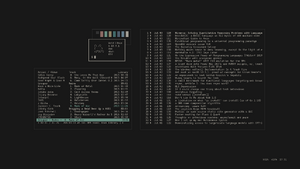More actions
m (added a screenshot preview) |
(removed user-made install guide, linked to official source instead) |
||
| Line 16: | Line 16: | ||
Like most minimalistic distributions, Void does not come with a graphical environment or any user utilities out of the box. However, they can be installed by the user later on. | Like most minimalistic distributions, Void does not come with a graphical environment or any user utilities out of the box. However, they can be installed by the user later on. | ||
==Installation== | ==Installation== | ||
A guide to installing Void Linux, among other useful information, is located on [https://docs.voidlinux.org/installation/index.html the documentation page]. | |||
==XBPS== | ==XBPS== | ||
The '''X Binary Package System''', commonly abbreviated as XBPS, is a package manager maintained and developed by the Void Linux team. It features, on top of the normal package management utilities, tools to help port packages (from .deb to .xbps, for example), to make your own package and others. A list of general-use XBPS commands can be found below. | The '''X Binary Package System''', commonly abbreviated as XBPS, is a package manager maintained and developed by the Void Linux team. It features, on top of the normal package management utilities, tools to help port packages (from .deb to .xbps, for example), to make your own package and others. A list of general-use XBPS commands can be found below. | ||
Revision as of 05:46, 15 November 2024
 The official Void logo | |
| Release Status | Maintained |
|---|---|
| Release Model | Rolling Release |
| Package Manager | XBPS |
| Default Desktops | Xfce (live image only) |
| Usage Type | Desktop |
| Architectures | amd64, aarch64, i686 |
| Website | voidlinux.org |

Void GNU/Linux is a rolling-release Linux distribution built from source (not based on anything). Void Linux is most commonly used on desktop systems for its lightness, minimalism and ease of setup. It is distributed for numerous architectures and also provides a rootfs tarball, and amongst other things, it also allows you to choose between a glibc and musl image.
Like most minimalistic distributions, Void does not come with a graphical environment or any user utilities out of the box. However, they can be installed by the user later on.
Installation
A guide to installing Void Linux, among other useful information, is located on the documentation page.
XBPS
The X Binary Package System, commonly abbreviated as XBPS, is a package manager maintained and developed by the Void Linux team. It features, on top of the normal package management utilities, tools to help port packages (from .deb to .xbps, for example), to make your own package and others. A list of general-use XBPS commands can be found below.
| Utility | Usage |
|---|---|
| xbps-install | Fetches a package and its dependencies from the repo and installs it |
| xbps-remove | Removes a package from the system |
| xbps-query | Used to do many things, like getting the total number of packages installed or searching for them in the repo |
| xbps-reconfigure | Reconfigures a specific package, allowing for additional customization or bugfixing |
